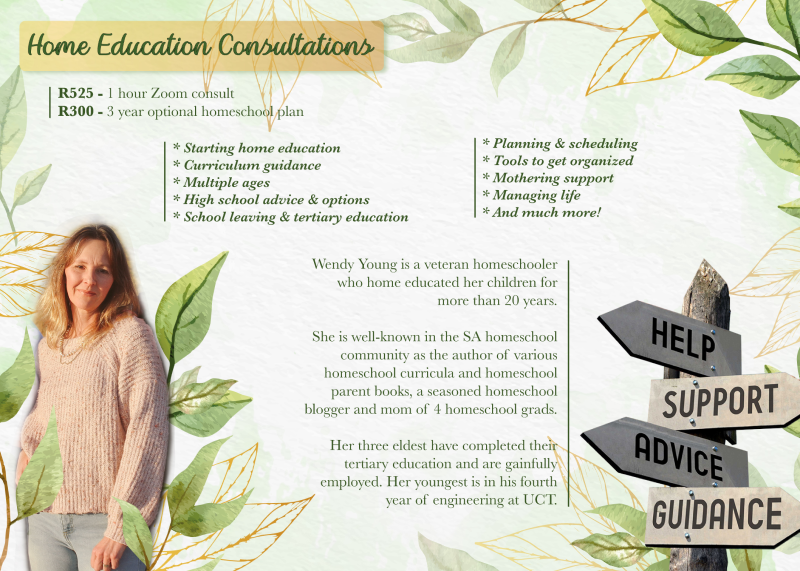Parents often ask how to start homeschooling in South Africa and need information about the procedure for removing a child from school. Sometimes a family’s circumstances change and they need to return a child to school after homeschooling for some time. They need information about readmission to school and how to deal with any challenges they may face.
First we will look at how to remove a child from school and lower down we provide vital information about returning a child to school.
How do you start homeschooling in South Africa?
What is the procedure for removing my child from school? ~ Carol, Cape Town
When removing your child from a school to start homeschooling in South Africa, you DO NOT need to ASK for permission or offer any explanations for doing so. Your child does not belong to the school or the department of education. Your children are your responsibility.
The Constitution, which is the highest law in the land states that in all decisions pertaining to a child, the best interests of a child are of paramount importance.
Section 28 of the Bill of Rights states in paragraph 2: “A child’s best interests are of paramount importance in every matter concerning the child.”
You, as the parents are fully capable of and entitled to choose the course of action and type of schooling that would be in your children’s best interest. Parents are assumed to be the best persons to judge what is in the best interests of their children, unless proven otherwise in a court of law.
Step 1 – Get legal backing
We recommend that you join the Pestalozzi Trust, the homeschool legal defence association in South Africa, before informing the school of your plan to remove your child from school and start homeschooling. Every family’s circumstances are unique, so if you have concerns, contact the Pestalozzi Trust for legal advice specific to your situation.
The Pestalozzi Trust offers legal backing should there be a case of conflict with the authorities. You can’t join afterwards if there is a problem, just like you can’t expect an insurance company to pay out AFTER you have a burglary or car crash! Regardless of what happens, we recommend joining as the Pestalozzi Trust keeps parents updated about changes in the law and practice of home education around the country. In different provinces, home educators sometimes face various challenges and the Trust empowers parents to deal with these matters effectively.
Step 2 – Notify the school
What must you do to remove a child from school?
You should simply inform the school of your decision, with as little detail or explanation as possible. You do not have to justify your choice. A very short letter or an email could accomplish this. Don’t go into lengthy explanations or make any complaints or accusations! Keep it short and business-like.
In general, give as little information from your side as possible. The Pestalozzi Trust usually advises parents to do the following:
- notify the school that you have transferred your child to home schooling and
- request the school to prepare transfer certificates for the child/ren.
Don’t be too concerned if the school seems reluctant to issue the transfer certificates as you probably won’t ever need them; they are of more importance to the school administration than to you.
If you receive any negative reaction, it is a good idea to request that all advice, suggestions, requests or threats made to you as parents should be put in writing.
However, if you follow the advice above, this would be unlikely.
You may also want to read about Registering for Homeschooling.
Get expert help to start homeschooling in South Africa
We know that starting homeschooling can seem daunting for parents. There are so many choices of curriculum and so many people giving sometimes conflicting advice and trying to urge you to do what they do.
We’ve been assisting homeschooling families for over 20 years, helping them to pick and mix the best curriculum options for their children at different ages and stages. We don’t just promote our own Footprints programmes (they only fill a small niche in your homeschooling journey). Instead we offer you insight about many options for maths, science, English and more, based on years of our own research for our own families and years of being part of the home educating community in South Africa.

If you have questions or you want guidance and tips to help you piece together a homeschooling plan for your family, book a homeschool consultation with Wendy Young. We believe its worth investing some time and money so that you home education pathway will go smoothly.
Must you register for homeschooling in South Africa?
More Homeschool Questions and Answers
Re-admission of a child to school
How do you re-enrol a child in school after homeschooling?
There are sometimes situations where parents decide to stop home education and place their children back in the school system. As with removing a child from school (above), we recommend that you get legal backing and join the Pestalozzi Trust, before engaging with the school system and the Department of Basic Education. The Trust will assist you with resolving any difficulties which may arise.
Private schools may set their own admission requirements, so this information below applies to placing children back into the state school system.
The Constitution says that children have a right to receive a basic education and this right is unqualified. This means that it is immediately realiseable and the state has a duty to ensure that all children’s right to education is fulfilled.
Therefore a state school that is not full may not refuse to admit a child who is of compulsory school age (between ages 7-15 years or in grade 9 or lower).
Article 5 of the SA Schools Act (Act 84 of 1995) states that a learner may not be refused admission if the parent can’t provide a school report. It was amended by Clause 4 of the BELA Act as follows:
Amendment of section 5 of Act 84 of 1996, as amended by section 2 of Act 50 of 2002
(4) Section 5 of the South African Schools Act, 1996, is hereby amended—
(a) by the substitution for subsection (1) of the following subsection:
‘‘(1) A public school must admit, and provide education to, learners and must serve their educational requirements for the duration of their school attendance without unfairly discriminating in any way.’’;
(b) by the insertion after subsection (1) of the following subsections:
‘‘(1A) Any learner whose parent or guardian has not provided any required documents, whether of the learner or such adult person acting on behalf of the learner, during the application for admission, shall nonetheless be allowed to attend school.
(1B) The principal of the school must advise the parent or guardian to secure the required documents.’’;
(c) by the substitution in subsection (4) for paragraph (a) of the following paragraph:
‘‘(a) The admission age of a learner to a public school to grade R is age four turning five by 30 June in the year of admission: Provided that, if a school has limited capacity for admission in grade R, preference must be given to learners who are subject to compulsory attendance.’’;
(d) by the substitution for subsection (5) of the following subsection:
‘‘(5) Subject to this Act and any applicable provincial law, the admission policy of a public school is determined by the governing body of such school in line with the Constitution and relevant legislation:
Provided that—
(a) the governing body, when considering the admission policy or any amendment thereof for approval, must be satisfied that the policy or the amendment thereof takes into account the needs, in general, of the broader community in the education district in which the public school is situated, and must take into account factors including, but
not limited to—
(i) the best interests of the child, with emphasis on equality as provided for in section 9 of the Constitution, and equity;
(ii) whether there are other schools in the community that are accessible to learners;
(iii) the available resources of the school and the efficient and effective use of state resources; and
(iv) the space available at the school for learners; and
(b) the Head of Department, after consultation with the governing body of the school, has the final authority, subject to subsection (9), to
admit a learner to a public school; and
(c) the governing body must review the admission policy determined in terms of this section every three years or whenever the factors
referred to in paragraph (a) have changed when circumstances so require, or at the request of the Head of Department.’’;
(e) by the substitution for subsection (9) of the following subsection:
‘‘(9) Any learner or parent of a learner who has been refused admission to a public school may appeal against the decision to the Member of the Executive Council within 14 days of receiving the notification of the refusal of admission to the public school.’’; and
(f) by the addition of the following subsections:
‘‘(10) If an appeal contemplated in subsection (9) has been received, the Member of the Executive Council must, within 14 days after receiving such an appeal, consider and decide on the matter and inform the learner or the parent of the learner of the outcome of the appeal.
(11) If the governing body is not satisfied with the decision of the Head of Department as contemplated in subsection (5)(b), the governing body may appeal against the decision to the Member of the Executive Council within 14 days after receiving the decision of the Head of Department.
(12) If an appeal contemplated in subsection (11) has been received, the Member of the Executive Council must, within 14 days after receiving such appeal, consider and decide on the matter and inform the governing body of the outcome of the appeal.
(13) While the Member of the Executive Council considers the appeal, the admission policy shall remain valid and applicable, and only the provisions that are the subject of the appeal shall be suspended pending the finalisation of the appeal process.’’.
This means that a public school that is not already full, breaks the law if it refuses to admit a child who has been home educated.
Furthermore, the school may not set any test relating to such admission and may not demand the results of an admission test performed by anyone else.
According to the Pestalozzi Trust, “the school has a right to conduct a placement assessment with the purpose to place the child in the appropriate grade, if there is reason to doubt that the proof of learning submitted to the school is sufficient. Schools may however not conduct any form of admission test i.e. a school cannot refuse to enroll a learner on the basis of a test.” [emphasis added]
According to the national policy on the admission of learners to public schools, children must be admitted according to the age-grade norm. In other words: the number six is subtracted from the age that the child reaches during the current academic year, and that is the grade that the learner MUST be placed in.
For example, if a child is turning 13, s/he must be placed in grade 7.
There have been some instances where a school was reluctant to admit a learner to a particular grade as the parents did not have a report stating that the child had passed the previous grade.
According to the government’s admission policy for public schools set out in the notice below, if a parent does not have a transfer card from another school, which home educators would not have, a parent may sign an affidavit stating that the learner was home educated and the grade the child should be placed in. Pay attention to the paragraph 19. (c) which we have highlighted with bold text below. (You can click on the title below to read the entire document, if necessary.)
- If the transfer card is not available the principal of the receiving school may admit the learner and place the learner in a grade on the basis of the following documentation:
(a) the last report card issued by the previous school;
(b) other equivalent documentation from the previous school; or
(c) a written affidavit of the parent stating the reason for not having the transfer card and the grade the learner attended at the previous school.
Paragraphs 26-29 in the above-mentioned document refer to the age-grade norm.
Paragraph 31 says:
In principle, learners should progress with their age cohort. Repetition of grades seldom results in significant increases in learning attainment and frequently has the opposite result.
If the school finds that your child does not cope with the grade level you state, then at a later stage, they may move the child down a grade (or up).
Below is an extract from an email written by a parent to a district-level government official, when administrative staff wanted to readmit a child to a lower grade, after the child had been home educated for one year, because there was no official school report confirming that the child had passed the last grade, while homeschooling. It demonstrates how knowledge of the law empowers a parent to advocate for his child. Names have been removed to protect their privacy. This event occured before the passing of the BELA Act in 2024, so the wording quoted may differ from the law that is now applicable, but in essence the argument remains the same. It’s an example of how you can use the letter of the law to assert and fight for your child’s rights, if necessary.
“I must remind you of the SOUTH AFRICAN SCHOOLS ACT NO. 84 OF 1996,
where it clearly states the following:
3. Compulsory attendance.
—(1) Subject to this Act and any applicable provincial law, every parent must cause every learner for whom he or she is responsible to attend a school from the first school day of the year in which such learner reaches the age of seven years until the last school day of the year in which such learner reaches the age of fifteen years or the ninth grade, whichever occurs first.
5. Admission to public schools.
—(1) A public school must admit learners and serve their educational requirements without unfairly discriminating in any way.
(2) The governing body of a public school may not administer any test related to the admission of a learner to a public school, or direct or authorise the principal of the school or any other person to administer such test.
Further, the age appropriate grade for [my child], who turns 14 this year is 14 less 6, which is 8. Thus he should be in Grade 8.
Further,
(7) An application for the admission of a learner to a public school must be made to the education department in a manner determined by the Head of Department
(8) If an application in terms of subsection (7) is refused, the Head of Department must inform the parent in writing of such refusal and the reason therefor.
(9) Any learner or parent of a learner who has been refused admission to a public school may appeal against the decision to the Member of the Executive Council
Therewith, the law is clear. We have a mandate by government to enrol our children at a school. [My child] is placed in an age appropriate grade. No assessments are legally allowed to be requested by your department. If you are refusing the learner, then an official letter must be drafted and sent, as per section 8 above.
I am not going to waste anymore of your, or my time, in this regard. [My child], was enrolled at [Name of] High School end 2016. We have a written letter of acceptance from the high school. [My child] is currently attending the school he was accepted at, in the standard he was enrolled in, and in his age appropriate grade. He will continue to do so, and we expect that he will be registered accordingly by the Education Body, as is required by law.
Should you feel differently then you will need to comply with section 8, as above, so we can take the necessary action.
Kind regards
[Parent’s name]”
After this, the child remained in Grade 8 and was registered as such by the officials of the Department of Education. Ironically, within a few weeks of returning their children to school, the family decided that home education was the better option after all and they have been homeschooling again ever since!
This page was last updated on 26 September 2024.
Homeschooling and the Law in South Africa
Be prepared. Be informed. Be empowered.
Read our other articles relating to Homeschool Laws in South Africa.
- Read this first – Disclaimer
- Pros and Cons of Registration for Home Education
- Must You Register for Homeschooling?
- What Could Happen if You Don’t Register?
- Be Properly Informed of the Legalities of Homeschooling
- Registering with the Department vs A Child’s Best Interests
- Are Home Visits Legal?
- Removing or Returning a Child to School
- Cottage Schools
Homeschool Assessments, Reports and Compliance
Part 1 – Homeschool Assessments
Part 2 – Homeschool Reports
Part 3 – Should You Submit Homeschool Reports?
Curriculum Compliance
School at Home versus Eclectic Homeschooling
Footprints and CAPS
Footprints Language Arts and CAPS
Barefoot Days and CAPS


